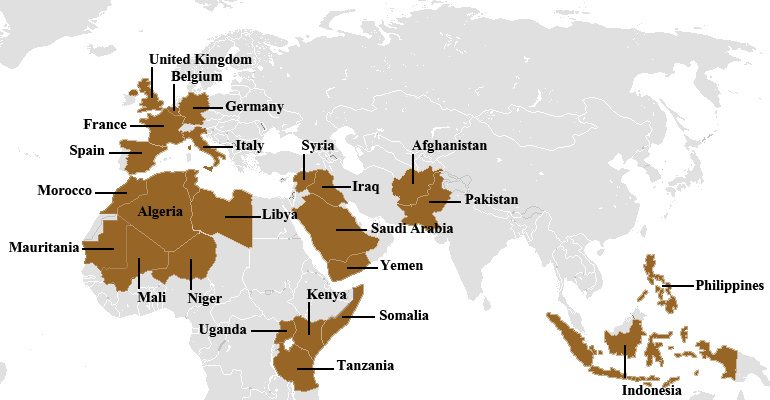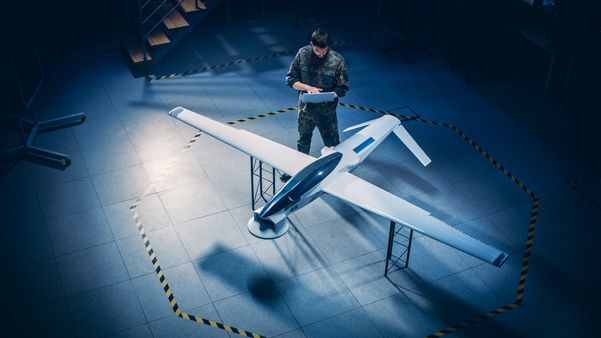Wracked by civil war, Syria is morphing into a petri dish for the incubation of al-Qaeda terrorists -- and it's beginning to infect neighboring nations.

Al-Qaeda has subsidiaries around the globe. Source: Wikimedia Commons.
Case in point: The New York Times reports that al-Qaeda-backed insurgents from Syria have already killed some 8,000 Iraqis this year -- mostly civilians. They're taking territory in Iraq, too, and in a series of brazen attacks al-Qaeda's "Islamic State in Iraq and Syria" subsidiary has inflicted more than 900 casualties on Iraqi security forces, including the Iraqi army's Seventh Division.
Iraq is nervous, and so... it's going shopping. For weapons.

10 ScanEagles are heading for Iraq. Source: Wikimedia Commons.
Iraq's after-Christmas shopping spree
Last month, Iraqi Prime Minister Nouri al-Maliki made a trip to Washington, D.C., to ask President Barack Obama for high-tech weaponry to help him beat back al-Qaeda's Syrian forces. Topping his shopping list are several dozen unarmed intelligence drone aircraft, which al-Maliki says he needs to help track insurgent movements.
According to NYT, these will include 10 of Boeing's (BA +1.45%) small ScanEagle unmanned aerial vehicles, and also four-dozen even smaller Raven UAVs from AeroVironment (AVAV 3.00%). Reportedly, the government has agreed to start delivering the drones early next year. In defense contracting terms, this sale is so small it barely registers -- perhaps $1 million for Boeing, and about $3 million for AeroVironment.
What the Iraqis really need, according to Washington Institute for Near East Policy analyst Michael Knights, as quoted in NYT, are "long-range, high-endurance armed drone[s]" such as General Atomics' Predator and Reaper UAVs. So far, Obama has not offered to sell those to Iraq.
Almost nothing in the stocking, but some big presents under the tree
What the president has agreed to do, though, is to sell lots of other weapons to Iraq.
In July, Congress received notice that the Defense Security Cooperation Agency intends to sell Iraq $1.95 billion worth of arms:
- 50 Stryker armored vehicles from General Dynamics (GD +0.23%)
- Spare parts needed to repair and maintain dozens of American-built howitzers, heavy trucks, and armored personnel carriers in the Iraqi arsenal
- A dozen of Textron's (TXT +0.34%) Bell 412 transport helicopters (one of the 10 most popular combat helicopters in the world). But none of the Apache attack helicopters that Iraq really wants.

Boeing's AH-64 Apache attack chopper. This is what Iraq really wants. Photo Source: Wikimedia Commons.
Other weapons, such as the 681 Stinger anti-aircraft missiles and 216 MIM-23P HAWK Tactical Missiles for which sales were approved in August, may be of less use in combating insurgents. They still add up to $2.4 billion for U.S. defense contractors, though.
Additionally, the Times broke news of a previously unreported sale of 75 Hellfire missiles to Iraq, which the Iraqis plan to place on their Cessna turboprop aircraft. Iraq has already placed orders for dozens of F-16s fighter jets from Lockheed Martin (LMT +0.66%), and just this month, Baghdad asked Korea Aerospace Industries to build it two-dozen warplanes based on Lockheed's successful T-50 design, to further beef up its air force.
But until those arrive, Iraq must make do with an improvised air force of jury-rigged Cessna attack aircraft, and a few million bucks worth of unarmed drones. Let's hope it's enough.

AeroVironment's Raven is not as scary as an Apache. Source: Wikimedia Commons.










